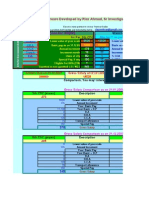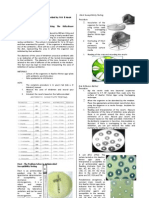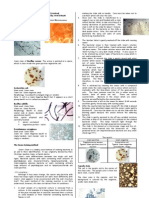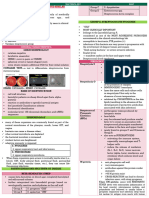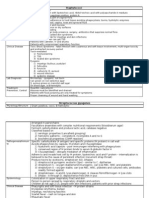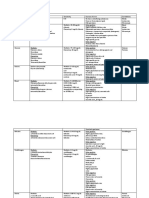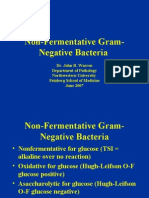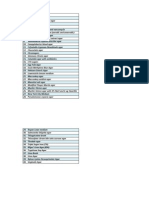Microbiology Charts
Microbiology Charts
Uploaded by
clower112Copyright:
Available Formats
Microbiology Charts
Microbiology Charts
Uploaded by
clower112Original Description:
Copyright
Available Formats
Share this document
Did you find this document useful?
Is this content inappropriate?
Copyright:
Available Formats
Microbiology Charts
Microbiology Charts
Uploaded by
clower112Copyright:
Available Formats
1. 2. 3. 4. 5. 6. 7. 8. 9. 10. 11. 12. 13. 14. 15. 16. 17. 18. 19. 20. 21. 22. 23. 24.
25. 26. 27. 28.
Sheep Blood agar Bacteroides Bile-esculin agar Bile esculin agar Brucella base agar Blood with kanamycin and vancomycin Phenylethyl alcohol agar (aerobic and anaerobic) Bordet-gengou Blood agar Buffered charcoal-yeast extract agar Burkholderia cepacia selective agar Campylobacter blood agar Cefsulodin-Irgansan-Novobiovin agar Chococlate agar Chromagars Simmons Citrate agar Columbia agar with antibiotics CTA sugars Egg Yolk Agar Eosin Methylene Blue Agar Hektoen Enteric Agar Lowenstein-Jensen medium Macconkey agar Macconkey sorbitol agar Mannitol salt agar Modified Thayer Martin agar Mueller Hinton agar Mueller hinton agar with 4% NaCl and 6 ug Oxacillin New York City Medium Pseudomonas cepacia agar
29. Regan-Lowe medium 30. Salmonella-Shigella agar 31. Thiogylcolate broth 32. Thiosulfate citrate bile salts sucrose agar 33. Tinsdale agar 34. Triple Sugar Iron (TSI) 35.KligersIronAgar(KIA) 36. Trypticase Soy Agar 37. Urea Broth 38. Urea Agar 39. Xylose-Lysine-Desoxycholate Agar 40. Vaginalis Agar
Type Enriched, Nonselective, and Differential (Detection of hemolysis) Selective and Differential Selective and Differential Nonselective nutrient medium Enriched and Selective Selective Enriched. May be made selective by adding antibiotics Nonselective and Enriched Selective and Differential Selective Selective and Differential Enriched and Nonselective Nonselective and Differential Differential Nonselective Differential Nonselective and Differential Selective and Differential Selective and Differential Nonselective Selective and Differential Selective Selective and Differential Selective Nonselective Nonselective Selective Selective
Selective Selective and Differential Nonselective Selective and Differential Selective and Differential Differential Differential Nonselective Selective Differential Selective and Differential Nonselective and Differential
Organisms That Will Grow Fastidious/Nonfastidious organisms. Ex: Staph, Strep, GPR, Most Neisseria species, etc. Isolation and Presumptive ID of Bacteroides fragilis group Isolation of Enterococcus species Cultivaton of many organisms Isolation of obligately anaerobic organisms Isolation of gram (+) organisms. Inhibition of gram (-) organisms Isolation of Bordetella pertussis and B. parapertussis Isolation of Legionella. Will also support the growth of Bordetella, Brucella, and Francisella tularensis Isolation of B. cepacia Isolation of Campylobacter jejuni subspecies jejuni and C. coli Isolation of Yersinia enterocolitica, which ferments mannitol and forms bullseye colonies. Also used to isolate Aeromonas from stool specimens Cultivation of fastidious organisms, including Haemophilus, Neisseria gonorrhoeae, and Brucella Isolation of MRSA Gram (-) bacteria ability to utilize citrate Cultivation of many organisms Determines if organisms can ferment various carbs: maltose, lactose, sucrose. Differentiates Neisseria and Moraxella species Identifiation of certain anaerobic isolates Isolation of nonfastidious GNR. Inhibition of gram (+) organisms. E. coli (Strong lactose fermenter), Shigella and Salmonella (Non-lactose fermenters) Isolation of Salmonella and Shigella. Inhibition of gram (+) organisms and some gram (-). Cultivation of Mycobacteria Inhibition of Gram (+) organisms. Isolation of many nonfastidious GNR, Ex. Enterics. Isolation of E. coli H0157:H7 Isolation of S. aureus, which uses mannitol and turns medium yellow. Inhibition of most gram (-) and many gram (+) organisms. Isolation of Neisseria gonorrhoeae Antimicrobial Susceptibility Tests Isolation of Neisseria gonorrhoeae Isolation of Neisseria species Isolation of Burkholderia cepacia (Previously known as Pseudomonas cepacia)
Isolation of Bordetella pertussis and B. parapertussis Isolation of Salmonella and Shigella. Inhibition of gram (+) organisms and some gram (-). Supports the growth of aerobes, anaerobes, and facultatives Isolation of Vibrio. Inhibition of many gram (+) and gram (-) organisms. Isolation of Corynebacterium diphtheriae Contains lactoe, sucrose, and glucose. Differentiates enteric organisms. Differentiates gram (-) enteric bacilli. Cultivation of fastidious and nonfastidious organisms. May be used as base for blood agar Tests for the presence of the enzyme urease Differentiates members of the Enterobacteriaceae group Isolation of Salmonella and Shigella. Inhibition of gram (+) organisms and some gram (-). Isolation of Gardnerella vaginalis, which is B-hemolytic on human blood.
Special Comments Nutritional base Inhibitors: Gentamicin and Bile Bile salts and Esculin Nutrients (Blood may be added) Inhibits gram (+) organisms Inhibitor: Phenylethyl alcohol Glycerol, potato infusion, and blood. Nutrients. Also inactivate toxic substances. Charcoal: Removes toxic substances. Nutrients: Yeast etract, cysteine, iron salts, and alpha-ketoglutarate Isolated from respiratory secretions Nutrient base, inhibitors: antimicrobial agents, blood may be added Inhibitors: Cefsulodin, irgasan, novobiocin, bile salts, crystal violet. Carb: Mannitol Nonfastidious organisms will also grow. Nutritional base, heated RBCs or other supplements None None Nutrient, blood/antibiotics may be added None None Inhibitors and pH indicators. Contains carbohydrate: lactose. Inhibitor: Bile salts. pH indicators: Acid fuchsin and bromthymol blue. Carbs: Lactose, sucrose, salicin. H2S system. Eggs, Malachite green Inhibitors: Bile salts and crystal violet. pH indicator: Neutral red. Carb: Lactose. None Inhibitor: 7.5% salt. pH indicator: Phenol red. Mannitol None Supplements may be added: Salt, cations (broth), sheep or lysed horse blood None None Contains antimicrobial agents
None Inhibitors: Bile salts, citrate, and brilliant green. pH indicator: Neutral red. Carb: Lactose. H2S system. Reducing agents: Thioglycollate, cystine, sodium sulfite. Agar: Reduces O2 diffusion. Inhibitors: Citrate, bile, and high pH. pH indicator: Bromthymol blue. Carb: Sucrose. H2S system. Tellurite: inhibitors many organisms None None Contains: Digested soybeans and casein None None Inhibitor: Bile salts. pH indicator: Phenol red. Carbs: Lactose, sucrose, xylose. Lysine. H2S system Contains: Nutrients, human blood
Bacitracin susceptibility CAMP test Hippurate Hydrolysis PYR hydrolysis Optichin susceptibility Bile esculin hydrolysis Salt-Tolerance Test X and V Factor Requirement Oxidase Spot Indol Catalase Coagulase Hydrogen sulfide production Urease Motility Vibriotstatic compound, O/129 disc test ONPG Deoxycholate Cefinase
Purpose/Principle Some organisms are suseptible to 0.04 units of bacitracin. Inoculate agar for confluent growth; add disk. Measure GBS make CAMP factor. S aureus makes B-lysin. Hemolysis enhanced when CAMP factor meets B-lysin. Test organ Hippurate ---(Hippuricase)---> Sodium benzoate + glycine. Detect either benzoate or glycine. Benzoate + Ferric chlo Chemical reaction - detects B-naphthylamine Inoculate agar plate for confluent growth with isolate. Place disk onto inoculate area. Incubate plate; measure zon 40% bile inhibits many organisms. Esculin ---> Esculetin + Glucose. Esculetin + Ferric ions --> Black 6.5% salt inhibits many organisms. Inoculate broth with organism Test organism inoculated onto trypticase soy agar or Mueller-Hinton agar, which lack X and V factors. Paper disk w Chemical Reaction - Detects indophenol Rub organism onto reagent-impregnated filter paper. Place organism on slide and add drop of H2O2. Detect bubbles Prepare saline suspension, mix in drop of plasma H2S + Iron or lead ----> Black Medium becomes alkaline as ammonia is produced Stab organism into semisolid agar deep Inoculate agar for confluent growth, add disks, incubate plate and measure zone Chemical reaction - Yellow color change in positive reaction Added to agar in order, visible pitting in the agar -- positive reaction Beta-lactamase detection
Pos. Rxn Susceptible: Any zone Enhanced hemolysis Benzoate: Precipitate, Glycine: Blue Red Susceptible: Zone > Cutoff Black Turbidity or acid pH Growth around disk Dark purple or Blue-black Blue-green Bubbles Cell clumping Black Red/pink Diffuse haze of growth throughout Any zone Yellow Pitting in agar Yellow to Red color change
Pos. Organism Micrococcus, GAS GBS GBS, Listeria, C. jejuni GAS, Enterococcus, Other gram (+) bacteria S. pneumoniae Enterococcus, GDS, Listeria Enterococci X only: H. ducreyi, V only: H. parainflu and H parahaemo., X and V: H. influ and H. haemo. Neisseria, Moraxella, Pseudomonas, B. cepacia, Vibrio, Aeromonas, and others E coli, P vulgaris, Morganella, Vibrio, Aeronomas, Plesiomonas, and others Staph, Micrococcus, Corynebacterium, Many Bacillus, and others S aureus Edwardsiella, Salmonella, Proteus K pneumoniae, Proteus, Morganella, Most Brucella, H pylori, and others Vibrio and Campylobacter (Darting), Bacillus, Many enterics, Aeromonas, and others Susceptible: Plesiomonas, Most V. cholerae E coli, Citrobacter, K pneumoniae, Enterobacter, S marcescens Enterics N gonorrhoeae, H influenzae, M catarrhalis, Enterococcus, Staph, Anaerobic bacteria
Neg. Rxn Resistant: No zone No enhanced hemolysis Benzoate: No precipitate, Glycine: No color No color change Resistant: No zone No color No turbidity or pH change No growth around disk No color change No color No bubbles No clumping No color Yellow Growth only near stab line No zone Colorless No pitting in agar No color change
Neg. Organism Staph, Stomatococcus, GBS, Other B-strep Groups A, C, D, F, and G Strep, Enterococci Groups A, C, F, and G Strep, Enterococci, Helicobacter Other Strep Other Strep Other Strep GDS not enterococci, Other Strep All other bacteria Enterics, S. maltophilia, Acinetobacter, Gardnerella Salmonella, K pneuoniae, Enterobacter, and others Clostridium, Fusobacterium, and others S saprophyticus, S epidermidis, Many other Staph species, Micrococcus E coli, Shigella, Klebsiella, Enterobacter, Serratia E coli, Shigella, Salmonella, S marcescens, P multocida Corynebacterium, Lactobacillus, Shigella, Klebsiella, Brucella, and others Resistant: Aeromonas Salmonella, Proteus, Providencia, Morganella Gram positive bacteria Non-B-lactamase bacteria
Urinary tract GenitalsandSTDs Upper Respiratory Tract Lower Respiratory Tract Ocular Skin and Soft Tissue (what about bone?) Gastrointestinal + Agents of possible food poisoning Central Nervous System Circulatory (blood)
Pathogens E coli, Other Enterobacteriaceae, S saprophyticus, P aeruginosa N gonorrhoeae, C trachomatis, T pallidum, H ducreyi S pyogenes, H influenzae S pneumoniae, H influenzae, S aureus, M tuberculosis S aureus, N gonorrhoeae, C trachomatis B burgdorferi, R ricketsii V cholerae, Salmonella, C jejuni, Shigella, C difficile, S aureus C botulinum, C tetanus, N meningitidis S pyogenes
Disease Associated UTI, Pyelonephritis Gonorrhea, Chlamydia, Syphillis, Chancroid Strep throat, Influenza Pneumonia, Tuberculosis Conjunctivitis (Infectious and Neonatal), Trachoma Lyme disease, Rocky Mountain Spotted Fever Cholera, Salmonella food poisoning Botulism, Tetanus, Meningitis Sepsis, Endocarditis
Areas Affected Bladder, Ureters, Kidneys Genitals Throat, Lungs Lungs Eyes Skin GI Tract CNS Heart, Blood Vessels
You might also like
- 6th Central Pay Commission Salary CalculatorDocument15 pages6th Central Pay Commission Salary Calculatorrakhonde100% (436)
- Clinical Corelation With Conditions For MorphologyDocument1 pageClinical Corelation With Conditions For MorphologyApollo OchiengNo ratings yet
- Aerobic Gram Negative Rods Flowchart 508Document1 pageAerobic Gram Negative Rods Flowchart 508Issa AlejoNo ratings yet
- Sir Alvin Rey Flores: Echinococcus Granulosus, Taenia Solium)Document5 pagesSir Alvin Rey Flores: Echinococcus Granulosus, Taenia Solium)Corin LimNo ratings yet
- Microbiology BacteriaDocument4 pagesMicrobiology BacteriaFarahh ArshadNo ratings yet
- Identification of Pathogenic Bacteria in Clinical Microbiology LaboratoryDocument70 pagesIdentification of Pathogenic Bacteria in Clinical Microbiology Laboratoryamare100% (4)
- Bacteria Classification FlowchartDocument1 pageBacteria Classification FlowchartLindsayNo ratings yet
- Microbiology CaseDocument3 pagesMicrobiology Caseclower112100% (2)
- High Yield - Bacteriology ChartsDocument54 pagesHigh Yield - Bacteriology Chartsadom09100% (1)
- Staphylococcus Spp. Gram Positive. ClusteredDocument15 pagesStaphylococcus Spp. Gram Positive. ClusteredIvy NNo ratings yet
- Laboratory # 3 Biochemical Differentiation of Some Medically ImportantDocument34 pagesLaboratory # 3 Biochemical Differentiation of Some Medically ImportantSirine AjourNo ratings yet
- Aubf Lab CSFDocument6 pagesAubf Lab CSFAndrei Tumarong AngoluanNo ratings yet
- Microbiology, Bailey - S and Scotts Chapter 28, Moraxella and Related Orgs. by MT1232Document3 pagesMicrobiology, Bailey - S and Scotts Chapter 28, Moraxella and Related Orgs. by MT1232Aisle Malibiran PalerNo ratings yet
- Mega Micro para Table 1 (1) (PDF - Io)Document81 pagesMega Micro para Table 1 (1) (PDF - Io)CheryldaneBaculiNo ratings yet
- Microbiology Memorization SheetDocument5 pagesMicrobiology Memorization Sheetalobrien100% (2)
- CC Conversion-FactorsDocument1 pageCC Conversion-FactorsAndrei Tumarong AngoluanNo ratings yet
- Differential Selective Bacterial Growth Media Microbiology Lecture Powerpoint VMCDocument20 pagesDifferential Selective Bacterial Growth Media Microbiology Lecture Powerpoint VMCMarina Dintiu0% (1)
- Staph and Strep SummaryDocument24 pagesStaph and Strep SummaryJihrus Mendoza100% (1)
- Non-Fermenting and Miscellaneous Gram Negative BacilliDocument33 pagesNon-Fermenting and Miscellaneous Gram Negative BacilliLin Sison Vitug100% (1)
- Microbio Lab 5Document2 pagesMicrobio Lab 5api-37432170% (1)
- Aerobic Gram Negative Rods FlowchartDocument1 pageAerobic Gram Negative Rods FlowchartKeithNo ratings yet
- Microbio Lab 8Document4 pagesMicrobio Lab 8api-3743217100% (5)
- Bacteriology PDFDocument49 pagesBacteriology PDFKat JornadalNo ratings yet
- Antibiotics Study Guide 2017Document13 pagesAntibiotics Study Guide 2017Josh BurkeNo ratings yet
- SuperDuperUltraMega Micro para Table 1 PDFDocument68 pagesSuperDuperUltraMega Micro para Table 1 PDFThea de la PeñaNo ratings yet
- Microbio Lab 9,10,11,12 & ReviewDocument3 pagesMicrobio Lab 9,10,11,12 & Reviewapi-374321750% (2)
- 01 Introduction To Clinical ParasitologyDocument5 pages01 Introduction To Clinical ParasitologyKaye Angel VillonNo ratings yet
- Clinical Parasitology Module 1 Merged 1Document174 pagesClinical Parasitology Module 1 Merged 1Hanan Ali BacarNo ratings yet
- Serologic Tests Part 1Document4 pagesSerologic Tests Part 1Joshua TrinidadNo ratings yet
- Recall 1Document4 pagesRecall 1pikachuNo ratings yet
- StreptococcusDocument6 pagesStreptococcusAyessa VillacorteNo ratings yet
- NO Hazard Slight Moderate Serious Extreme: Hazard Hazard Hazard HazardDocument74 pagesNO Hazard Slight Moderate Serious Extreme: Hazard Hazard Hazard HazardCristy Jean100% (1)
- Me EnterobacteriaceaeDocument72 pagesMe Enterobacteriaceaewimarshana gamage100% (1)
- Clinical Lab DilutionsDocument19 pagesClinical Lab DilutionsAlex Joshua Maglasang100% (1)
- SuperDuperUltraMega MicroPara Table 2Document74 pagesSuperDuperUltraMega MicroPara Table 2SamNo ratings yet
- LAB - BACTE - Bacterial Identification Methods and Strategies TABULAR - FINALS - 001Document16 pagesLAB - BACTE - Bacterial Identification Methods and Strategies TABULAR - FINALS - 001Jashmine May TadinaNo ratings yet
- Staphylococci: Streptococcus PyogenesDocument20 pagesStaphylococci: Streptococcus PyogenesPharmacy2015100% (2)
- Automated Antimicrobial Susceptibility Test MethodDocument2 pagesAutomated Antimicrobial Susceptibility Test MethodJoshua TrinidadNo ratings yet
- Coagulation Tests Interpretation PT PTTDocument45 pagesCoagulation Tests Interpretation PT PTTD. F.No ratings yet
- Microbiology: Presented by Alyazeed Hussein, BSCDocument64 pagesMicrobiology: Presented by Alyazeed Hussein, BSCT N100% (1)
- Section 1 Pages 1-54Document54 pagesSection 1 Pages 1-54rihamalrajehNo ratings yet
- Common Plating Media For Clinical Bacteriology (From Bailey & Scott's Diagnostic Microbiology, 12th Ed)Document2 pagesCommon Plating Media For Clinical Bacteriology (From Bailey & Scott's Diagnostic Microbiology, 12th Ed)Elizabeth Enjambre HernaniNo ratings yet
- Summary of Reagent Strip TestsDocument8 pagesSummary of Reagent Strip TestsDarla YsavelNo ratings yet
- Additional ProtozoanDocument2 pagesAdditional ProtozoanMary ChristelleNo ratings yet
- 1.1 Gram Positive CocciDocument9 pages1.1 Gram Positive CocciJustine Mel Concepcion IlardeNo ratings yet
- Assessment Micro 2016 Clin CorDocument28 pagesAssessment Micro 2016 Clin CorPerlie CNo ratings yet
- A. Staphylococcus Aureus B. Staphylococcus Epidermidis C. Staphylococcus SaprophyticusDocument8 pagesA. Staphylococcus Aureus B. Staphylococcus Epidermidis C. Staphylococcus SaprophyticusRuel MaddawinNo ratings yet
- Review Parasitology ChartsDocument8 pagesReview Parasitology Chartseezah100% (2)
- MTK Myco ViroDocument16 pagesMTK Myco ViroJustine Alexandrea RamirezNo ratings yet
- Drummelsmith - Laboratory Diagnosis and Bacterial Identification - Study GuideDocument19 pagesDrummelsmith - Laboratory Diagnosis and Bacterial Identification - Study GuideTom TsouNo ratings yet
- Histotechnology Study TipsDocument4 pagesHistotechnology Study TipsApollo OchiengNo ratings yet
- Hematology ManualDocument233 pagesHematology ManualharpreetNo ratings yet
- Blood Bank Technology Specialist - The Comprehensive Guide: Vanguard ProfessionalsFrom EverandBlood Bank Technology Specialist - The Comprehensive Guide: Vanguard ProfessionalsNo ratings yet
- Urinalysis and Body Fluids - Strasinger, Susan King, Di Lorenzo, Marjorie SCDocument38 pagesUrinalysis and Body Fluids - Strasinger, Susan King, Di Lorenzo, Marjorie SCHughNo ratings yet
- Culture MediaDocument64 pagesCulture MediaEffy AngeLi LomocsoNo ratings yet
- Praktikum Mikro.Document44 pagesPraktikum Mikro.Albi MaulanaNo ratings yet
- 4 Stool Culture PDFDocument35 pages4 Stool Culture PDFVenny PatriciaNo ratings yet
- bergeys manual ταυτοποιηση μικροβιωνDocument8 pagesbergeys manual ταυτοποιηση μικροβιωνvafeasNo ratings yet
- Identification Flowcharts Bacteria - Bergey'sDocument8 pagesIdentification Flowcharts Bacteria - Bergey'sMicro BioNo ratings yet
- Presentation DocumentDocument3 pagesPresentation Documentclower112No ratings yet
- Hematology Study GuideDocument2 pagesHematology Study Guideclower112No ratings yet
- Clinical Chemistry NotesDocument1 pageClinical Chemistry Notesclower112No ratings yet
- Clinical Chemistry NotesDocument24 pagesClinical Chemistry Notesclower112100% (3)
- Clinical Chemistry NotesDocument1 pageClinical Chemistry Notesclower112No ratings yet
- Lab AboDocument5 pagesLab Aboclower112No ratings yet
- Lab 3,4,5Document2 pagesLab 3,4,5clower112No ratings yet
- Slide ReticsDocument1 pageSlide Reticsclower112No ratings yet
- Non-Fermentative Gram-Negative BacteriaDocument9 pagesNon-Fermentative Gram-Negative BacteriaHamidou OuedraogoNo ratings yet
- IUMS2014, ProceedingDocument1,487 pagesIUMS2014, Proceedingamir-scribdNo ratings yet
- USP 2024 60 Microbiological Examination of Nonsterile Products Tests For Burkholderia Cepacia ComplexDocument3 pagesUSP 2024 60 Microbiological Examination of Nonsterile Products Tests For Burkholderia Cepacia ComplexAnuar Mohd SimohNo ratings yet
- PH and Temperature in Gram Negative MicrobesDocument10 pagesPH and Temperature in Gram Negative MicrobesIoanna DivNo ratings yet
- Stenotrophomonas, Achromobacter, and Nonmelioid Burkholderia Species: Antimicrobial Resistance and Therapeutic StrategiesDocument12 pagesStenotrophomonas, Achromobacter, and Nonmelioid Burkholderia Species: Antimicrobial Resistance and Therapeutic StrategiesValentina Lcpc CajaleonNo ratings yet
- DS PM BBL-Prepared-Plated-Media BR EN PDFDocument21 pagesDS PM BBL-Prepared-Plated-Media BR EN PDFKniat TainkNo ratings yet
- Minocycline One - Pager PDFDocument2 pagesMinocycline One - Pager PDFInês GouveiaNo ratings yet
- Re Mel CatalogDocument322 pagesRe Mel CatalogErica FitriNo ratings yet
- Comparative Efficacy of Doripenem Versus MeropenemDocument8 pagesComparative Efficacy of Doripenem Versus MeropenemaamirNo ratings yet
- Antibiotic Treatment For Cystic FibrosisDocument102 pagesAntibiotic Treatment For Cystic Fibrosischar1356No ratings yet
- 03-Non-Fermentative Gram-Negative Bact Eria v1 - 3 2Document56 pages03-Non-Fermentative Gram-Negative Bact Eria v1 - 3 2Abiola Olumuyiwa OlaitanNo ratings yet
- Microbial Limits Tests: The Difference Between "Absence of Objectionable Microorganisms" and "Absence of Specified Microorganisms"Document7 pagesMicrobial Limits Tests: The Difference Between "Absence of Objectionable Microorganisms" and "Absence of Specified Microorganisms"Jai MurugeshNo ratings yet
- PARA - B. Hominis - PsuedomonasDocument27 pagesPARA - B. Hominis - PsuedomonasMary ChristelleNo ratings yet
- Cystic Fibrosis With Case StudyDocument27 pagesCystic Fibrosis With Case StudyAviva Tuteja100% (1)
- NonfermentersDocument3 pagesNonfermentersFaithNo ratings yet
- NGUYEN2259602021PCBMB9876Document13 pagesNGUYEN2259602021PCBMB9876asri roselyNo ratings yet
- Re Mel CatalogDocument327 pagesRe Mel Catalogdiego.bNo ratings yet
- Pharmatech Wrongful Death SuitDocument17 pagesPharmatech Wrongful Death SuitChris GothnerNo ratings yet
- Anitbiotic Treatment in Cystic FibrosisDocument76 pagesAnitbiotic Treatment in Cystic FibrosisOxana TurcuNo ratings yet
- Pseudomonas An UpdateDocument82 pagesPseudomonas An Updatetummalapalli venkateswara raoNo ratings yet
- Micro Not in SketchyDocument4 pagesMicro Not in Sketchyrpascua123No ratings yet
- Microbiology ChartsDocument17 pagesMicrobiology Chartsclower112No ratings yet
